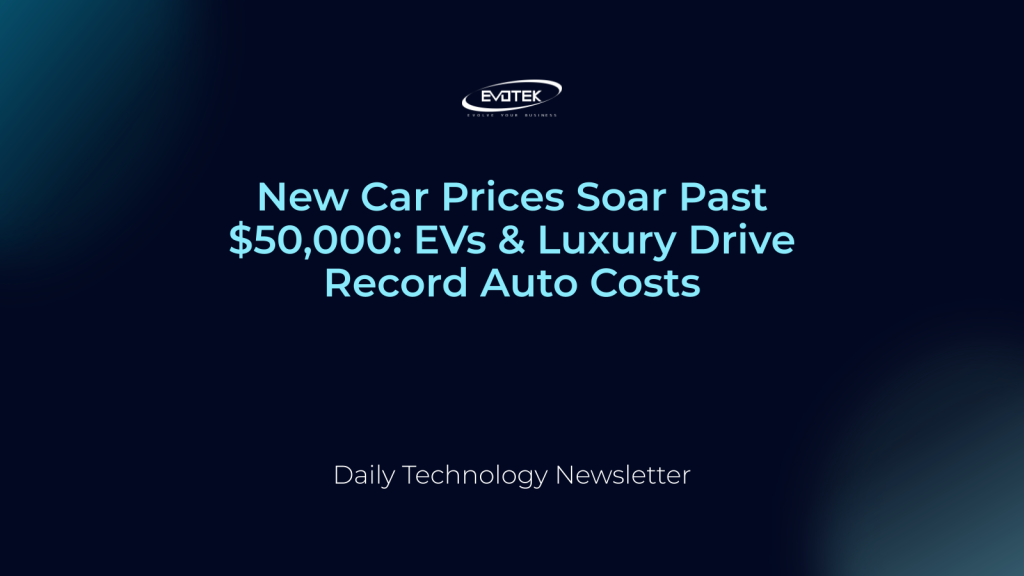The average price paid for a new vehicle in the United States has exceeded $50,000 for the first time, a significant milestone driven by a surge in demand for electric vehicles (EVs) and high-end luxury models. This unprecedented increase marks a pivotal shift in the automotive landscape, creating new challenges for budget-conscious consumers.
Just five years ago, a new car typically cost around $40,000. Today’s average of over $50,000 highlights the rapid escalation of prices and a fundamental change in what Americans consider a “standard” new car purchase. This evolving market increasingly caters to affluent buyers and technologically advanced vehicles, with economic pressures and regulatory changes reshaping both supply and demand dynamics.
Electric Vehicles Lead the Price Surge
At the forefront of this price increase is the growing popularity of electric vehicles. According to Kelley Blue Book data, EVs accounted for a record 11.6% of all new vehicles sold last month in the U.S.
- The average electric vehicle sold for an estimated $58,124, reflecting a 3.5% increase from August.
- Total EV sales for the third quarter reached nearly 438,000 units, representing a 10.5% market share and an almost 30% jump compared to the same period last year.
A rush to purchase EVs was also observed following the expiration of a $7,500 federal tax credit for buyers. While incentives slightly declined in September compared to August, they remained higher than earlier in 2024, influencing buying decisions.
Luxury Segment Continues Its Ascent
The luxury vehicle segment also played a substantial role in driving up average transaction prices. More than 60 models boasting an average sticker price exceeding $75,000 contributed to 7.4% of new car sales in September, an increase from 6% a year prior. This expanding upper tier of the market indicates the sustained capacity of wealthier households to absorb rising costs and invest in premium vehicles.
Affordability Crisis: The Disappearance of Budget Cars
For many Americans, the dream of an affordable new car is fading. The once-common $20,000 vehicle has largely vanished from dealership lots. Consequently, budget-focused consumers are increasingly turning to the used car market or opting to keep their existing vehicles longer. Data from S&P Global reveals the average age of cars on U.S. roads now surpasses 12 years.
Strained Financing for New Car Buyers
Financing trends underscore the growing strain on buyers seeking new cars:
- Average monthly payments have crossed the $750 threshold.
- Seven-year loans are becoming more prevalent.
- A staggering one in five new car buyers now faces monthly payments exceeding $1,000.
These extended loan terms are a direct response to elevated vehicle prices, but they also introduce greater financial risks for consumers stretching their budgets to afford desired models.
Economic Policies and Future Outlook
Broader economic policies, such as President Donald Trump’s tariffs, have also impacted September’s pricing dynamics, introducing billions of dollars in additional costs for automakers on imported vehicles and parts. While automotive companies have largely absorbed these costs to maintain sales, analysts caution that ongoing tariffs will eventually necessitate price increases to sustain profitability, potentially exacerbating the current affordability crisis.
Despite these inflationary pressures and ongoing supply chain disruptions, the market’s trajectory is predominantly shaped by the burgeoning demand for electric and luxury vehicles. Tesla, though still a dominant force in the EV market, saw its average transaction price at $54,138 in September and its market share dip below 50% for the first time, reflecting a broader selection of competitive electric models now available to consumers.
Industry observers anticipate that the increasing proliferation of new EV models and elevated inventory levels could help stabilize or even reduce prices in the future. However, the complex interplay of policy changes, economic conditions, and consumer preferences will continue to define the evolving automotive market.

 日本語
日本語 한국어
한국어 Tiếng Việt
Tiếng Việt 简体中文
简体中文